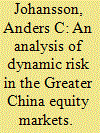|
|
|
Sort Order |
|
|
|
Items / Page
|
|
|
|
|
|
|
| Srl | Item |
| 1 |
ID:
089969


|
|
|
|
|
| Publication |
2009.
|
| Summary/Abstract |
This study looks at the time-varying nature of systematic risk in the Greater China equity markets. The Shanghai and Shenzhen markets both have a low average systematic risk when measured against the world market. The short outbursts in systematic risk for these two markets seem to be directly related to policy shifts. The Hong Kong and Taiwan markets are more integrated with world markets and they show signs of large variations in systematic risk over time. Furthermore, conditional betas in the Shanghai and Shenzhen markets are stationary, while the Hong Kong and Taiwan betas are integrated of order one. In addition, long memory tests show that all four markets exhibit a long-run dependence in their conditional betas. While the two mainland China market betas are covariance stationary, the Hong Kong and Taiwan betas are not.
|
|
|
|
|
|
|
|
|
|
|
|
|
|
|
|
| 2 |
ID:
140012


|
|
|
|
|
| Summary/Abstract |
Value at risk (VaR) is used by financial experts to calculate and predict the risk of financial exposure. In the presence of volatility and long memory, it is a model useful for the prediction of loss in the equity index return series. Checking the accuracy of this model is necessary from the practitioners’ point of view. This article initially checks the presence of autoregressive conditional heteroscedastic (ARCH) and long-memory effects in the daily closing price of the Bombay Stock Exchange (BSE)-BANKEX return series. After confirming the ARCH and long-memory presence, it analyses the different methods of VaR calculation such as asymmetric power ARCH (APARCH), fractionally integrated exponential generalised ARCH (FIEGARCH), hyperbolic generalised GARCH (HYGARCH) and risk metrics. Then, it empirically tests the forecasting capacity of these VaR methods through techniques such as the Kupiec likelihood ratio (LR test) and dynamic quantile test. Furthermore, it checks the root-mean-squared error (RMSE) and mean absolute error (MAE) to determine the model with the least error. From the set of VaR models used here, by and large it concludes that the BANKEX return series has both long-memory and asymmetry effects. By comparing these models, it is implied that the HYGARCH model gives a better result, although the other models have their significance in the estimation and forecasting of the BANKEX return series.
|
|
|
|
|
|
|
|
|
|
|
|
|
|
|
|
| 3 |
ID:
111388


|
|
|
|
|
| Publication |
2012.
|
| Summary/Abstract |
This study examines the degrees of time persistence in U.S. total renewable energy consumption using innovative fractional integration and autoregressive models with monthly data from 1981:1 to 2010:10. The results indicate that renewable energy consumption is better explained in terms of a long memory model that incorporates persistence components and seasonality. The degree of integration is above 0.5 but significantly below 1.0, suggesting nonstationarity with mean reverting behavior. The presence of long memory behavior (persistence) in renewable energy consumption suggests that random shocks may very well move renewable energy consumption from pre-determined target levels for a period of time.
|
|
|
|
|
|
|
|
|
|
|
|
|
|
|
|
| 4 |
ID:
088994


|
|
|
|
|
| Publication |
2009.
|
| Summary/Abstract |
Previous studies that have tested for a unit root in aggregate energy consumption have potentially reached misleading conclusions because they fail to allow for the possibility that energy consumption might be fractionally integrated and do not distinguish between different types of energy consumption. This study tests for long memory in disaggregated petroleum consumption in the United States using univariate and multivariate Lagrange multiplier (LM) tests for fractional integration. The results point strongly to the need to distinguish between different forms of energy consumption and allow for a generalization of the I(0)/I(1) dichotomy when considering the order of integration of energy consumption. Allowing for short-run dynamics, the univariate test suggests that less than 50% of the series are fractionally integrated. Consistent with expectations the non-stationary series are found to have the highest mean and standard deviation. The multivariate test suggests that petroleum consumption in the commercial and industrial sectors is clearly fractionally integrated when allowing for short-run dynamics, and, as such, exhibits persistent effects, while petroleum consumption in the residential sector is a stationary process.
|
|
|
|
|
|
|
|
|
|
|
|
|
|
|
|
| 5 |
ID:
132625


|
|
|
|
|
| Publication |
2014.
|
| Summary/Abstract |
The main goal of this paper is to investigate whether the long memory behavior observed in many volatility energy futures markets series is a spurious behavior or not. For this purpose, we employ a wide variety of advanced volatility models that allow for long memory and/or structural changes: the GARCH(1,1), the FIGARCH(1,d,1), the Adaptative-GARCH(1,1,k), and the Adaptative-FIGARCH(1,d,1,k) models. To compare forecasting ability of these models, we use out-of-sample forecasting performance. Using the crude oil, heating oil, gasoline and propane volatility futures energy time series with 1-month and 3-month maturities, we found that five out of the eight time series are characterized by both long memory and structural breaks. For these series, dates of breaks coincide with some major economics and financial events. For the three other time series, we found strong evidence of long memory in volatility.
|
|
|
|
|
|
|
|
|
|
|
|
|
|
|
|
|
|
|
|
|